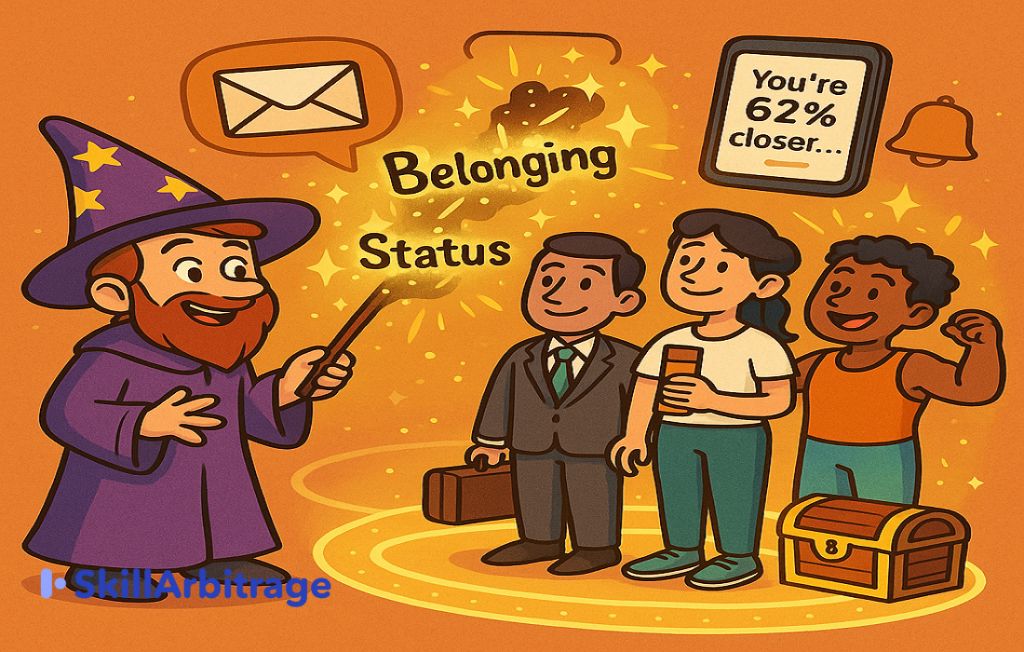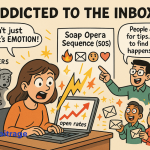This blog holds the key to making customers stay. It gives a five-step framework to create retention-based copy across mediums and channels and explains why retention is the bloodline of all businesses. Content writers, marketers, and strategists would find it very useful.
Table of Contents
Introduction
Ping!
There was a message from another popular OTT channel I subscribed to telling me that I was missing out on my favorite shows!
“Hey, Sunayani missing out on your favourite shows? Check them out now!”
I took a look, realized I missed those shows and wanted desperately to know why the husband was acting guilty in that crime thriller. I remembered why I liked the app. And dutifully after work, I logged in.
This is how copy aimed to retain customers generally worked. It reminds you of what it has to offer, of what you are missing out on, and uses psychological triggers to retain you as a consumer.
This part of the copy is not glamorized or constantly in the spotlight as the ads or the blogs.
Most Indian businesses stop at conversion. They think retention is about sending the occasional discount code or newsletter.
But retention is a science. It’s about writing copy that builds loyalty, reduces churn, and keeps your subscribers hooked—month after month. Like my OTT platform had just managed to do with great effect.
Let’s explore how you can master the art of retention in the subscription economy.
Whether you’re writing for OTT, edtech, health, or D2C—this one’s for you.
I’ll take you through the importance of retention copy and why it matters now, more than ever. We would also explore how psychological triggers like belonging, status, and commitment help retain customers. I would also take you through an actionable 5-step framework that makes the art of retention super easy.
Ready?
Let’s dive in.
Retention is growth
When writing for a subscription brand, remember this: keeping a customer is cheaper than acquiring a new one.
According to a Bain & Company study, a 5% increase in customer retention can lead to a 25–95% increase in profits.
That is huge!
Effectively doing this one thing right i.e. retaining consumers can make or break a business.
Add to it the Indian twist: a market where churn is high, income is price-sensitive, and competition is fierce, here your retention copy must work harder.
It must do double duty to inform as well as reaffirm value every single week.
The booming retention-based economy in India
The subscription-based economy is new to India but it is growing at a remarkable pace, especially in industries like OTT, edtech, D2C, and healthtech, projected to grow at a huge pace in the next two years.
Take a look at this screenshot.
(Source: https://ijamrsd.com/wp-content/uploads/2025/03/JAMRSD-02-03-2023_6.pdf)
Platforms like Netflix, Unacademy, and Nykaa are shifting focus from acquisition to retention to build a loyal subscriber base.
Price-sensitive consumers and fierce competition make retention critical, with brands investing in personalized copy to build loyalty. For example, Zomato’s Gold membership uses push notifications to remind users of savings and Nykaa uses push notifications of new collections to lure customers back.
If the consumer is not coming back for more then you have lost them already!
As Indian consumers embrace subscriptions for convenience and value, mastering retention copy is no longer an option. It is something that every content writer must learn to do to tap into this booming field.
But before I tell you how to make consumers stay, let’s explore why they leave.
Why customers leave—and how copy can fix it
There are three major reasons why customers unsubscribe or churn:
They forget the value
If the product’s usefulness isn’t constantly reinforced, they assume it’s not worth paying for. Suppose you have joined an online dance class because you always wanted to.
You started with every intention to do all classes and finish all assignments but then you missed one class. You said to yourself, “No harm done. I will attend all sessions from now on.”
Then you missed more classes, other priorities took up your time, and you forgot why this class was so important. Eventually you discontinued and asked for a refund.
Sounds familiar? That’s what happens when a consumer is not reminded by the service provider exactly why they signed up in the first place.
They feel disconnected
If there’s no emotional bond, they leave at the first inconvenience.
Let’s go back to the example of online dance classes. You had joined with great enthusiasm, but then you did not like the class. You found the teacher dismissive, the steps too hard, and your fellow students indifferent. You didn’t really want to be there, but you had paid upfront, so you convinced yourself that you must.
Then one day class was cancelled without prior notice and you finally felt justified in walking out…and you do.
If the service or product fails to forge a human bond, the customer does not stay.
They don’t see progress
If users don’t feel like they’re growing, saving, or achieving something, they stop showing up.
Similar to sitting through the dance class but feeling as hopeless and afraid of the steps as you were before you joined. You failed to see the purpose and you left.
If the customer does not see how the product or service has made their life better, they do not see any point in continuing.
When they leave the brand has to spend a lot again to find fresh leads. The process has to start from scratch, and that’s a drain on the marketing budget.
Retention copy is the key to solving all three problems.
And how does it do that?
It uses psychological triggers—deep needs that, when activated, keep people coming back.
3 psychological triggers for deadly effective retention copy
Belonging (I am not alone)
Human beings are social animals. They are wired to seek community. If your copy makes users feel like they’re part of something larger—a tribe, a challenge, a cause—they stay longer.
Examples:
- “Join 78,000 learners who are building a career in tech.”
- “You’re part of a movement to reclaim your health—one workout at a time.”
Status (I am improving)
People want to feel and be better than they were yesterday. This is what motivates them to learn, experience, feel, and make connections.
They stay when your copy reinforces that they’re getting smarter, fitter, richer, or more evolved.
Examples:
- “You’ve completed 84% of the course. That’s more than 92% of users!”
- “Your 3rd month as a Pro Member. Most users quit in month one. You didn’t.”
Commitment (I’ve come too far)
Once users have invested time, effort, or emotion, they are less likely to leave. Retention copy reminds them of their progress and nudges them to continue.
Examples:
- “You’ve built a 67-day meditation streak. Let’s not break it now.”
- “Still with us after 6 months? You’ve already done the hard part.”
These triggers have to be built in at every retention touchpoint—emails, in-app nudges, push notifications, and microcopy.
They are the little things that create a deep impact, on the customer’s decision to stay.
Want to know how to do it?
Here’s a 5-step framework!
The 5-step retention copy framework
Use this framework whenever you write for a subscription product. It helps build momentum and stickiness:
Do these five things and you will find it works like a charm.
Hard to believe?
Let’s see this in action.
Example 1: Skill-based EdTech
Think Unacademy or SkillArbitrage.
Product: A monthly career coaching + upskilling platform for Indian professionals
Copy:
Subject: You’re 62% closer to your next job switch.
Body:
Remember when you joined to land that ₹20L job?
Here’s what you’ve achieved so far:
✅ Completed 9 out of 12 live sessions
✅ Resume shortlisted by 3 recruiters
✅ Joined our top-tier cohort for mock interviews
You’re in the top 15% of performers this month. Most people give up after 1 session. You didn’t.
Next step? Your 1-on-1 resume review is scheduled for Thursday. Don’t miss it.
This mail uses status, commitment, and anticipation to convince the customer to stay and it has a high chance of succeeding.
Let’s look at another category, completely different from an ed-tech, to see how the retention seduction unfolds over other forms of messaging and if it remains true to character across all of them.
Example 2: D2C skincare subscription box
Imagine a brand like Nykaa or Ayurveda.
Product: Monthly curated skincare products for Indian millennials
Copy (push notification):
You’ve stuck to your routine for 4 months. Your glow is catching attention. Ready for next month’s ritual?
In-app message:
You started your skin journey with hydration. You moved on to barrier repair.
Now it’s time for advanced glow therapy.
Your May box drops in 3 days. Sneak peek? Niacinamide + Cica serum with anti-pollution actives.
Subscribers who finish 6 months get access to our dermatologist hotline.
These messages are much shorter than the ed-tech email but they all use psychological triggers like tracking progress, informing of the next offer, and offering rewards down the line.
The only thing they have in common is the 5-step framework proving its effectiveness across mediums.
- Remind of Value: Highlight why they signed up.
- Example: “Remember your goal: a ₹20L job?”
- Track Progress: Show tangible achievements to reinforce status.
- Example: “You’ve completed 9/12 sessions—top 15%!”
- Build Belonging: Connect them to a community or cause.
- Example: “Join 78,000 learners building a tech career.”
- Create Anticipation: Tease upcoming benefits to maintain excitement.
- Example: “Your May box drops in 3 days: Niacinamide serum!”
- Reward Commitment: Offer incentives for staying to leverage commitment.
- Example: “6 months unlocks our dermatologist hotline.”
Which mediums mostly use retention copy and how to write them
You have already seen how different mediums use different versions of retention copy. They can show up anywhere in the post-purchase customer journey.
But they are more prone to show up more in some mediums, and each of those mediums deserves a different writing style.
Let’s take a quick look at them.
Each medium supports retention, but the key is to write like you’re guiding a journey—not just blowing up phones.
The principle remains the same: retention copy is not an afterthought—it is the brand’s voice that keeps people coming back.
Want to know how to cater to the Indian market specifically?
I have got you covered.
Examples of Indian market retention copy
Indian consumers are generally price-sensitive and emotional. We are the people who haggle to reduce two bucks from some spinach prices and huddle together to watch masala family potboilers on our TV screens.
Constant reminders of how much value they are getting for their money work like magic for Indian consumers.
Addressing price sensitivity with value-driven copy
Indian consumers are often price-conscious, especially in competitive markets like D2C or edtech. Retention copy should emphasize the tangible value of a subscription to justify its cost.
Example (Edtech Push Notification):
“Your ₹499/month course has saved you ₹10,000 in coaching fees. Complete your next module to unlock a free career webinar!”
This highlights cost savings and adds an incentive, reinforcing the subscription’s worth.
Using regional languages or colloquial phrases
India’s linguistic diversity (22 official languages, countless dialects) means retention copy can build emotional bonds by using local languages or culturally relevant phrases.
Example (D2C Skincare Email in Hindi):
“Aapki twacha ki chamak ab sab notice kar rahe hain! Apna 3rd month ka box kholo aur naye glow serum ka maza lo.”
(Translation: “Everyone’s noticing your skin’s glow! Open your 3rd-month box and enjoy the new glow serum.”)
This feels personal and culturally relevant, fostering a sense of belonging.
Leveraging cultural values like aspiration or family
Indian consumers are driven by aspirations (e.g., career success, good academic results) and family values.
Retention copy can tap into these to create emotional connections.
Example (OTT In-App Message):
“Your subscription brings joy to the whole family! Finish watching Kahaani Ghar Ghar Ki this weekend and make your parents proud with your next quiz win.”
This ties the subscription to family bonding and personal achievement, encouraging continued engagement.
Final thoughts
If you’re writing for Indian subscription brands and you’re not thinking about retention, you’re leaving money on the table.
The future of copywriting isn’t just about acquisition. It’s about keeping the people you’ve worked so hard to win.
Use this five-step framework to write superb retention-based copy, every time.
Write with belonging. Trigger commitment. Build.







 Allow notifications
Allow notifications
